The combination of skill level and task difficulty gives you 8 different mood experiences, including flow, stress, and boredom. These are feelings for a task. Most moods or general experiences of work are affected by a person’s skill and the complexity of the task they have at hand. This is given by the experience fluctuation chart, which can inform UIUX decisions and employee task assignments and also help calibrate user experience.
Mihaly Csikszentmihalyi, the torchbearer of positive psychology, studied how a person’s skill level and challenge at work create unique moods during work that affect productivity and work satisfaction. These experiences are changeable, and an organization can modify the experiences by changing the combination of an employee’s tasks and skills. Most employees would also experience all of them throughout their careers because of constantly changing work demands.
This approach can be used to MODIFY and PREDICT someone’s learning experience, work productivity, and app design, though I’ve focused mainly on work productivity.
The experience fluctuation chart
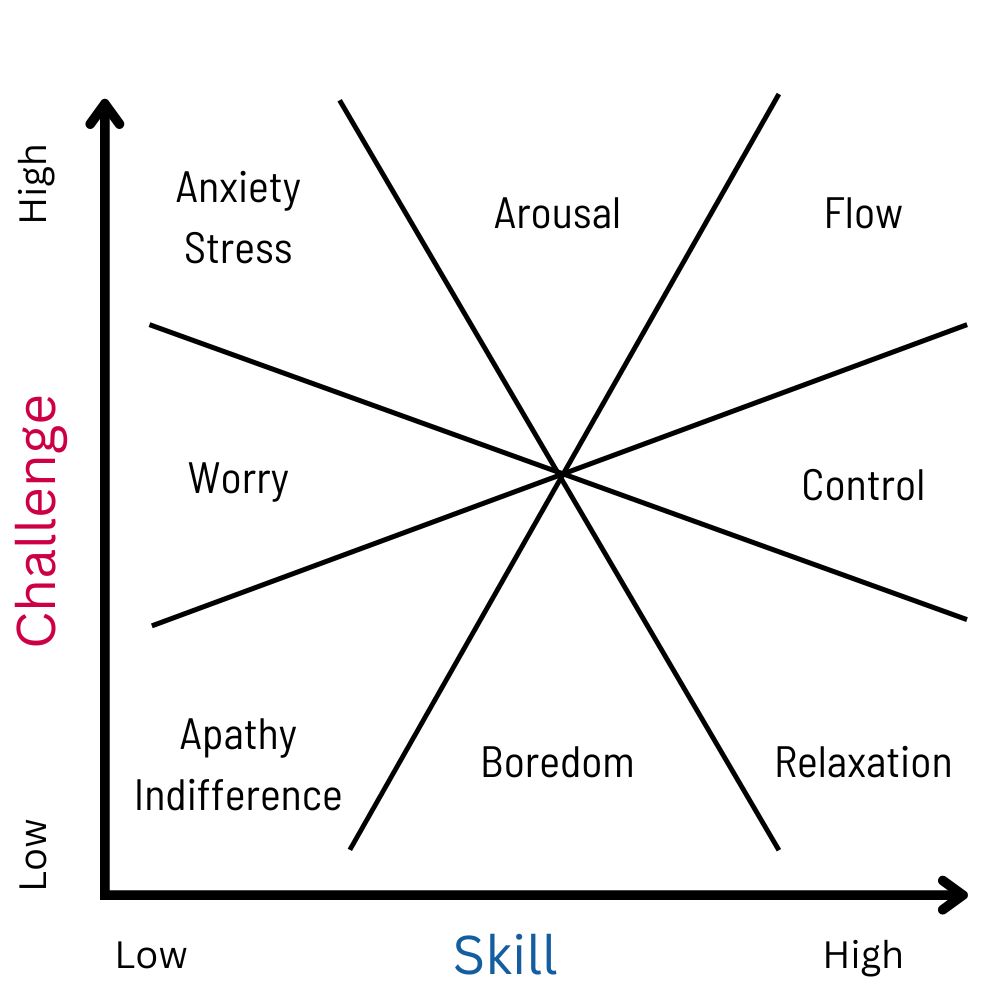
Each of the 8 experiences is based on a combination of your current skill level and the challenge you experience at work. From an employee perspective, this defines the mood and gives an idea of what must change to like work better. From an employer’s point of view, the chart tells us what needs to change for employees to feel more invested and act more productively.
| Mood | Challenge | Skill | Productivity |
|---|---|---|---|
| Apathy/Indifference | Low | Low | Low |
| Worry | Medium | Low | Low |
| Anxiety/Stress | High | Low | Low/Moderate |
| Boredom | Low | Medium | Low |
| Neutral/typical (not in the chart) | Medium | Medium | Moderate/typical |
| Arousal | High | Medium | High |
| Relaxed | Low | High | Low |
| Control | Medium | High | High |
| Flow | High | High | High |
- Apathy/Indifference: Work feels meaningless and unstimulating. This is also when a person feels heavily distracted because the work itself is not attention-grabbing enough.
- Worry: There is mild concern about doing work, but usually manageable. Stress from management and the environment also adds to this.
- Anxiety/Stress: Work difficulty causes stress based on a self-evaluated lack of skill, including self-esteem issues and low confidence. Physical symptoms of stress, mental health problems, and burnout occur here, leading to other problems like hating the job (or task). The work environment is also a large contributor here, but that’s a different story.
- Boredom: Demotivated or negative feelings around work; person wishes to avoid this as much.
- Arousal: High enthusiasm for work and high engagement.
- Relaxed: Work feels easy but unstimulating.
- Control: Truly manageable with feelings of achievement. There is curiosity, progress, and motivation here.
- Flow: Intense state of focus and engagement with a task with happy feelings. More about flow and how to achieve it here.
Quick highlights
If the challenge is high and your skill is low, you experience worry, stress, and anxiety. This is a gateway to procrastination and distractibility because procrastination is about avoiding stress and improving mood.

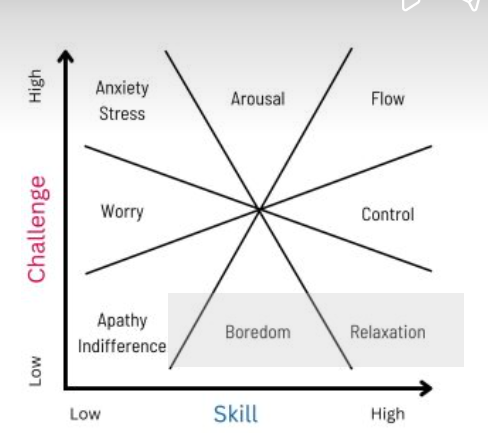
If the challenge is low and your skill is high, you feel bored or relaxed. If boredom is too high, one will conclude the work makes no sense, and they will crave work that feels more meaningful.
If you are moderately skilled and feeling challenged, you are motivated and aroused at work. Productivity rises along with intrinsic motivation[1].
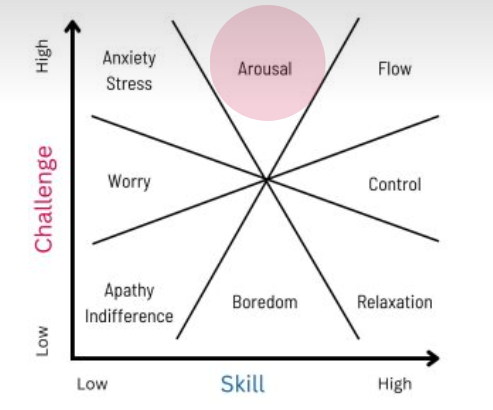
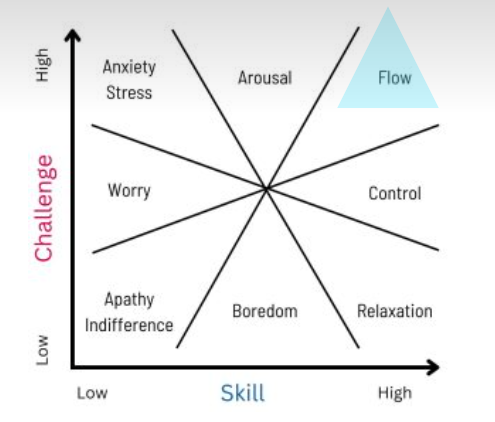
And finally, if you feel challenged at the limit of your capacity and your skill is high, you enter the glorious productive flow state. It is defined as feeling one with the task where you believe you have high skill and are working at the limits of your skill with a slightly higher challenge and sense of purpose.
Productivity and motivation across the 8 experiences
Marta Bassi and Antonella Delle Fave[2] studied the experience fluctuation model for everyday life situations and mapped 8 behaviors and motivations per mood that are relevant to doing work. The chart below is from their paper, and is discussed extensively in their book here[3].
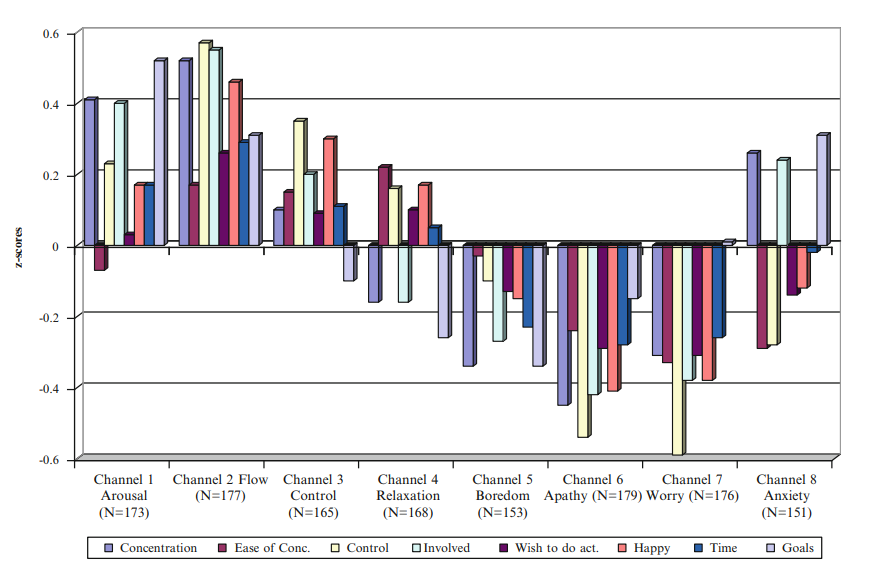
Ease of conc.: How easy it is to get focus and regain it after getting distracted
Control: How manageable the work is
Involved: How engaged you are
Wish to do act.: The literal intention to put in effort to progress
Happy: A feeling of joy at work
Time: How fast time flows
Goals: How goal-oriented you feel during an activity
A quick glance at the chart shows that when a person is in the aroused state, which is moderate skill and high challenge, there is high concentration, willingness to act, happiness, control over work, a sense of involvement, and a clear path to achieving specific goals. In the flow state, which is a deeply focused state of being involved with a task, there is overall more productivity with higher involvement and happiness.
However, for experiences like relaxation, apathy (indifference), and boredom, which is feeling no challenge regardless of your skill level, motivation and productivity are completely down. A person won’t feel involved, won’t be able to concentrate, doesn’t feel there are goals to achieve, and have no motivation to act toward their goals. For anxiety, there is a sense of reaching goals, high concentration, and a sense of involvement, but low motivation to act and low happiness. This is in line with how anxiety works – anxiety is about seeking safety when there is an imagined threat – so the brain increases focus, but is in conflict, so there is low motivation.
For teachers who want students involved or employees who want an engaged productive workforce, it’s best to reduce relaxation, boredom, and indifference but increase arousal, control, and flow. All 3 of these good experiences come with feeling challenged at any skill level. So if the level of challenge is equal to one’s skill or higher, the chance of these productive behaviors occurring is high.
Simple relaxation techniques like deep breathing, taking breaks, or even scrolling on the phone can temporarily shift the mood at work. But the biggest differences come from changing how complex the work feels and upgrading skills. But for this to also work out, someone should ideally identify if there is a good match between an employee’s skill and task difficulty.
For overall employee satisfaction, multiple moods are necessary. One should not expect an employee to be in flow all minutes of the day or be relaxed for weeks at a time. The mix of different experiences are important because they make mental life richer. If there is no variability in everyday work, chances are the day is highly predictable and an employee becomes indifferent to it. One study[4] shows that some variation in the experiences creates a buffer against exhaustion in restaurant servers. The emotional variability, however, might not be good for entrepreneurs. One study[5] found that an entrepreneur’s emotional variability was related to worse psychological well-being, but being very goal-oriented minimized the negative effect on well-being. One speculated reason is that entrepreneurs are particularly in an uncertain form of work, so they ideally need more emotional stability to deal with that uncertainty. For them, a core mood like flow or control mixed with small recovery breaks is a better deal than reducing boredom.
Multi-tasking and music: How they affect your mood
In a previous article, I highlighted how people could improve focus by multi-tasking and listening to music when the task is boring or unstimulating. And how multi-tasking and music can also hamper your productivity when the work is difficult.
Since perceived difficulty or boredom is a combination of skill and the task, music and multi-tasking can completely shift your experience at work from boredom to arousal or from control to fully distracted. Music and multi-tasking can spread your attention across multi-people areas either making the task more enjoyable, more challenging, or more varied (and less boring).
For highly skilled people, a task can be boring even when it is difficult for those with low skills. So choosing to multi-task or use background music depends on how your skill matches your work difficulty.
UI/UX and employee workflow insights
Given that these 8 experiences are characteristically different from each other and highly controllable, UI/UX designers can focus on how every single task on an app creates a sense of difficulty or ease based on a user’s inherent skill.
For example, should a professional audio software be as easy as possible? Should a pro photo editor focus on functionality for easy outputs or give maximum control to an already trained user? If a user has habits from other apps or how things were previously done, changing that habit for the same function can make something feel more difficult than it is. Simply because it burdens the user with more learning. From a design perspective, maintaining old habits and using skeuomorphic principles will reduce task difficulty.
Should a manager begin with an easy outline for the work or give employees a complex, intangible goal to deliver on? Each decision at these steps will determine an employee’s or user’s mood. Let’s look at an example.
For first-time engineering recruits, a senior engineer can give an outline of coding requirements and a structure. This reduces perceived difficulty compared to “we need users to get good TV show recommendations on our brilliant OTT”. When combined with high engineering skills, a recruit can go into flow while working step-by-step on a complex problem. But might go into apathy or anxiety without that structure. And if the task is too easy, like doing a simple login-password REGEX, a highly skilled engineer will feel relaxed and unmotivated. Similarly, giving this engineer the task of completing a module in the code with a rough structure, who has sufficient training, there might be enough arousal and challenge to feel excited about work.
While recruiting employees or onboarding users, variations in how they deal with the app might come from the mix of challenge and skill too.[6]Even if everyone is onboarded with perfectly defined demographic variables or recruited with the highest cut-off standards, the very nature of interacting with an app or a team brings the focus to a balance of skill and challenge. And that’s where variation in productivity or app usage comes from.
Later on, this variation is used for feedback to improve the workforce or the app. And that’s where understanding task difficulty and skill is valuable.
Generalizability
The experience chart can be generalized to many other domains. I’ve given the equivalents of Skill and Challenge for other demographics.
| Employee | Skill | Challenge |
| Student | Previous knowledge | Difficulty level |
| Consumer | Confidence in decision-making | Ease of product features |
| App user | User habits with other apps | App complexity |
Sources
[2]: https://link.springer.com/chapter/10.1007/978-3-319-28634-1_12
[3]: https://link.springer.com/book/10.1007/978-90-481-9876-4
[4]: https://psycnet.apa.org/buy/2013-12146-001
[5]: https://www.sciencedirect.com/science/article/abs/pii/S0883902616303986
[6]: https://www.researchgate.net/publication/271728164_A_Systems_Approach_to_Diagnosing_and_Measuring_Teamwork_in_Complex_Sociotechnical_Organizations

Hey! Thank you for reading; hope you enjoyed the article. I run Cognition Today to capture some of the most fascinating mechanisms that guide our lives. My content here is referenced and featured in NY Times, Forbes, CNET, and Entrepreneur, and many other books & research papers.
I’m am a psychology SME consultant in EdTech with a focus on AI cognition and Behavioral Engineering. I’m affiliated to myelin, an EdTech company in India as well.
I’ve studied at NIMHANS Bangalore (positive psychology), Savitribai Phule Pune University (clinical psychology), Fergusson College (BA psych), and affiliated with IIM Ahmedabad (marketing psychology). I’m currently studying Korean at Seoul National University.
I’m based in Pune, India but living in Seoul, S. Korea. Love Sci-fi, horror media; Love rock, metal, synthwave, and K-pop music; can’t whistle; can play 2 guitars at a time.



























